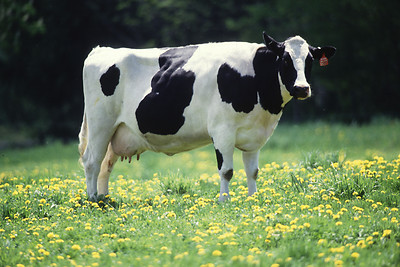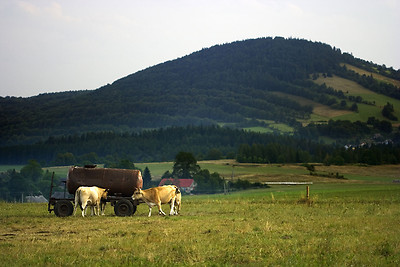Grass Fed Beef or By-Product Feedstuffs? You Decide!
 Monday, August 29, 2011 at 11:05PM
Monday, August 29, 2011 at 11:05PM By Leslie Why Reap
(If you are looking for Nutritional Evolution, Step II , it will be posted in 2 weeks. You need time to evolve!)
 Yes it is true. Cows like grass. They love it fresh but they will take it dried as well. They have the digestive system to handle it too, four stomachs in all, pretty great stuff. But wait, did you know that cows eat other things too? I knew that they ate corn and soy to make them nice and fat and produce a lot of milk but what I did not know until recently was that it doesn't stop there. They are also fed what are called "by-product feedstuffs." Hmmmm sounded suspicious to me. I needed to know more. More importantly, I needed to validate just why I should seek out and pay more for this “new" grass fed beef. Here is some of what I found….
Yes it is true. Cows like grass. They love it fresh but they will take it dried as well. They have the digestive system to handle it too, four stomachs in all, pretty great stuff. But wait, did you know that cows eat other things too? I knew that they ate corn and soy to make them nice and fat and produce a lot of milk but what I did not know until recently was that it doesn't stop there. They are also fed what are called "by-product feedstuffs." Hmmmm sounded suspicious to me. I needed to know more. More importantly, I needed to validate just why I should seek out and pay more for this “new" grass fed beef. Here is some of what I found….
The following are some of the "by-product feedstuffs" commonly used in dairy cattle diets in the Upper Midwest."*
1. Candy: Candy products are available through a number of distributors and sometimes directly from smaller plants…They are sometimes fed in their wrappers….Candies, such as cull gummy bears, lemon drops or gum drops are high in sugar content.
2. Bakery Wastes: Stale bread and other pastry products from stores or bakeries can be fed to dairy cattle in limited amounts. These products are sometimes fed as received without drying or even removal of the wrappers.
3. Potato Waste: Available in potato processing areas, and includes cull potatoes, French fries and potato chips. Cull fresh potatoes that are not frozen, rotten, or sprouted can be fed to cows either whole or chopped. Potato waste straight from a processing plant may contain varying amounts of inedible or rotten potatoes. French fries and chips contain fats or oils from frying operations.
4. Starch: Unheated starch is available from some candy manufacturers and sometimes may contain pieces of candy.
5. Pasta: Available from pasta plants and some ingredient distributors as straight pasta or in blends with other ingredients, such as candy.
Alright, well I learned something new…something new and unappetizing and hard to believe. However, let's assume that it could be true since we know that stranger things have happened to our food sources, unfortunately.
 Before modern agriculture was bestowed upon us; all the animals that humans ate were from "grass fed,” foraging, "free ranging" kinds of beasts and beings. These creatures were ideal for disease free, human health. Guess what? Man has not evolved that much, we still have only one stomach and these foods are still ideal. Are our available, organic, grass fed meats as ideal as the ancient mastodon or woolly mammoth? Perhaps not but they will have to be our best substitute in the face of extinction and “progress.”
Before modern agriculture was bestowed upon us; all the animals that humans ate were from "grass fed,” foraging, "free ranging" kinds of beasts and beings. These creatures were ideal for disease free, human health. Guess what? Man has not evolved that much, we still have only one stomach and these foods are still ideal. Are our available, organic, grass fed meats as ideal as the ancient mastodon or woolly mammoth? Perhaps not but they will have to be our best substitute in the face of extinction and “progress.”
Why is grass fed better you may still wonder? One reason is that these grass fed bovine do not eat soy or corn which they would not be able to properly digest. Corn and soy would alter the PH in their guts, inviting an overgrowth of bad bacteria. They are not given hormones, antibiotics or other drugs and carry a significantly lower risk for e.coli bacteria. Perhaps even more importantly, grass fed beef is better because these animals eat fresh or dried clean grass that is not only high in Omega 3 fatty acids, it is also a concentrated, natural source of CLA, Conjugated Linoleic Acid, a critical Omega 6 fatty acid. This grass based diet then yields beef that has the ideal Omega-6 to Omega-3 ratio of 3:1. The fatter, grain-fed bovine brethren on the other side of fence, have a disease inviting ratio of up to 20:1. Not surprisingly, this deadly imbalance of Omega-6 to Omega-3 fatty acids is also reflected in the disease inviting, grain based, typical American diet. Experts recommend that a healthy diet provide an Omega-6 to Omega-3 ratio that is the same found in grass fed beef…3:1. Despite being an Omega 6 fatty acid, naturally occurring CLA has only positive effects. Finally, grass fed products are also richer in antioxidants; including vitamins E, beta-carotene, and vitamin C. Grass-fed beef is lower in fat than regular beef and, more importantly, contains up to 5x more CLA.
What does CLA do for you?
- Helps fight cancer and diabetes
- Helps you to lose weight
- Increases your metabolic rate, a positive benefit for promoting normal thyroid function
- Helps you maintain normal cholesterol and triglyceride levels
- Enhances your immune system
- Promotes lean muscle development and lower body fat (I like the sound of that last bullet!)
After lots of research, here is the bottom line….Grass-fed beef is better for human health than grain-fed beef in ten different ways, according to the most comprehensive analysis to date. The 2009 study was a joint effort between the USDA and researchers at Clemson University in South Carolina**.
Compared with grain-fed beef, grass-fed beef was:
1. Lower in total fat
2. Higher in beta-carotene
3. Higher in vitamin E (alpha-tocopherol)
4. Higher in the B-vitamins thiamin and riboflavin
5. Higher in the minerals calcium, magnesium, and potassium
6. Higher in total omega-3s
7. A healthier ratio of omega-6 to omega-3 fatty acids (1.65 vs 4.84)
8. Higher in CLA (cis-9 trans-11), a potential cancer fighter
9. Higher in vaccenic acid (which can be transformed into CLA)
10. Lower in the saturated fats linked with heart disease
So now you can have your steak (grass fed) and eat it too! On a more serious note, grass fed lean cuts of red meat are an integral part to a Paleo/Primal lifestyle and will provide an ideal amount of Essential Fatty acids as well as the protein we need to stay strong. In addition, stop and look at the impact that grain based diets have had our nation's cattle, dairy cows, chickens and other animals. They get nice and fat, nice and fast and oh yes, much sicker overall. What do you think a grain heavy diet might be doing to you?
References
*This list is excerpted from "By-Product Feedstuffs in Dairy Cattle Diets in the Upper Midwest," published in 2008 by the College of Agricultural and Life Sciences at the University of Wisconsin at Madison.
**S.K. Duckett et al, Journal of Animal Science, (published online) June 2009, "Effects of winter stocker growth rate and finishing system on: III. Tissue proximate, fatty acid, vitamin and cholesterol content."
 by-product feedstuffs,
by-product feedstuffs,  grass fed beef in
grass fed beef in  Nutrition
Nutrition 

Reader Comments